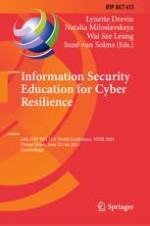2021 | Buch
Information Security Education for Cyber Resilience
14th IFIP WG 11.8 World Conference, WISE 2021, Virtual Event, June 22–24, 2021, Proceedings
herausgegeben von: Lynette Drevin, Dr. Natalia Miloslavskaya, Prof. Wai Sze Leung, Prof. Suné von Solms
Verlag: Springer International Publishing
Buchreihe : IFIP Advances in Information and Communication Technology
